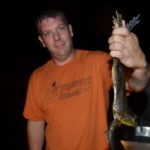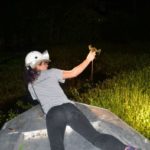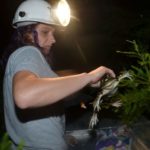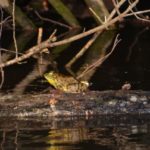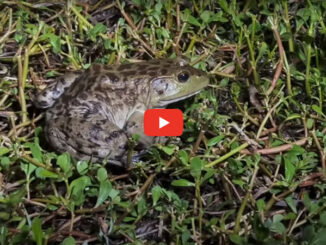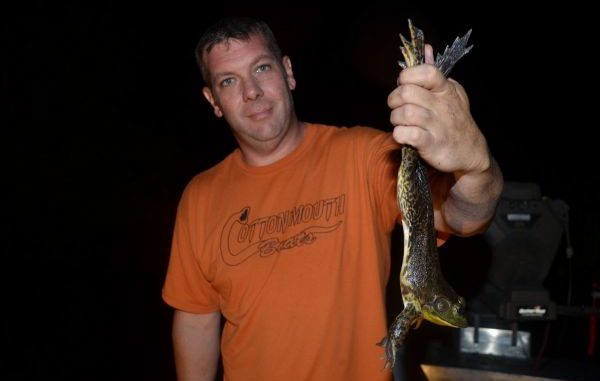
The Atchafalaya Basin and its associated waterways are full of fish, but there other creatures draw this couple out night after night. Learn why they love frogging and how they maximize their efforts.
“Now that’s a hammer there,” rumbled the 35-year-old man as he closed the boat in on a turbo-sized bullfrog sitting on a rare piece of exposed bank.
The amphibian was so big it looked like one of those concrete frogs city folks use to decorate their lawns.
The catcher — a very attractive 31-year-old female — didn’t disappoint the captain: She stretched far in front of the boat’s bow and, with deadly accuracy, clamped her fingers across the frog’s broad back.
Corey Crochet didn’t have to compliment his wife Samantha’s skill. He was used to it enough that he took it for granted.
By all rights, we should have cancelled this trip. It had rained almost nonstop for six days and six nights, stopping just an hour before we left the couple’s Greenwell Springs home.
“My neighbor has started building an ark,” Corey quipped when I called to confirm the trip.
Besides it not being fun to frog in the rain, heavy rains raise water levels and flood every low place in the swamp. Bullfrogs, being willing travelers, immediately scatter to hunt in the newly flooded areas.
Besides being hard to locate, hunting them in water too shallow to float a boat is tough — real tough.
I’ve kept up with Corey ever since he caught his 6-pound, 13-ounce IGFA world-record white bass in 2010. For the last year, it seemed like every time I called him, he and Samantha (who Corey and all their friends call “Sam”) had just gotten back from a night of frogging.
Grrr!
It happened again and again — grrr!
I happen to love frogging (and eating them) more than almost anything. Finally, I couldn’t take it anymore and just blurted out, “Why don’t you ever invite me?”
Corey answered innocently.
“I was wondering why you haven’t asked,” he said. “I thought maybe you didn’t like frogging.”
Smart Alec!
During the hour-and-a-half drive toward the Atchafalaya Basin, Corey tossed out-loud the decision of whether to go all the way to the public launch at Bayou Sorrell to hunt inside the levees of the basin or to stop short at Jack Miller’s Landing to hunt the swamps outside of the levees.
“There’s going be a lot of boats in the Spillway (inside the basin levees),” he said. “A lot of places in the Grand River area stay frogged out by the locals — places where you can get to the frogs with an outboard.
“With this boat, we can get to where they can’t, especially after this rain.”
Corey builds boats and was towing an 18-foot welded aluminum hull he designed specifically for use with a surface-drive engine. Hung on the stern of this one was a 35-horsepower Gator-Tail GTR.
“This is a test run for the boat, which I built for a friend,” he explained earlier.
It was still raw aluminum, but will end up painted blue metal flake.
“Its home will be Grand Isle,” Corey said.
The water at Jack Miller’s Landing was high, and the moisture in the air threatened rain. The couple efficiently launched the boat in the dark, and Carey turned its bow south in Grand River.
“Oh, man,” he moaned in anticipation.
Sam, curled up like a cat on a beach towel in the bow grinned at her husband’s excitement.
Corey turned the boat out of the river into Sullivan Lake.
“This is normally very shallow,” he explained.
From the lake, he slipped into a slough that would have been even shallower but for the high water.
A tangled, green jungle bordered each side of the slough. Corey immediately started spotting frogs.
“There’s a good, wide set of eyes,” he breathed as he turned the boat toward the frog.
Sam quickly nabbed that one.
The next one pleased Corey, too. It was what he called an “eater,” one big enough to eat.
Corey doesn’t like little frogs, so he soon became unhappy. The pair of lights (Sam wore one, too) swept the vegetation and logs. Eyes sparkled everywhere, but they belonged to frogs that were all too small to bother catching.
“Let’s try another area,” Corey murmured.
He pulled into an oil-field canal and promptly fell in behind another frog-hunting boat — not where you want to be.
But the other boat didn’t ruffle him a bit.
“They won’t get where we are going with an outboard motor,” Corey tossed off.
The Gator-Tail pushed the boat into a dense thicket of buttonwood bushes woven together with floating logs. The frogging got worse instead of better; instead of finding more small frogs, they found no frogs.
Corey piloted the boat into another spot. Still no frogs.
He stopped the motor and strategized out loud, ticking off his options. He whipped out his iPhone and checked its GPS.
“The water is really high,” Corey said. “It’s all in the woods, and that really scatters (the frogs).”
The night was beautiful, even if the frogs weren’t cooperating. Earlier, we had moved through an egret and heron rookery. Hundreds of the big. white and slate-blue gray wading birds festooned the cypresses like ornaments on Christmas trees.
It was 1:25 a.m., and the couple had two frogs in the boat.
Sam pulled her towel out from under her and used it to bundle up against the chill of the night air.
“Don’t worry,” Corey said, cheerfully. “We’ll get more. We’re die-hards.”
Finally, they begin seeing frogs here and there — frogs that were mostly eaters. Sam lunged to grab each one from her position sprawled on the boat’s bow deck.
“This will be one of those nights that we’ll have to pick at them,” her husband predicted.
Corey nosed the bow of the boat into a slough that had a tale.
“This is where the biggest frog I’ve ever seen got away from me,” Corey said dramatically.
He named the legendarily-sized frog “Cow Patty” because of its size.
Cow Patty wasn’t there that night, but other good-sized frogs were. The slough was choked with floating vegetation and clumps of cutgrass that reached 6 feet above the water.
The frogs were nestled in odd nooks and crannies in the vegetation, and because he couldn’t see more than a few feet from the boat, he had to grind through it back and forth in an irregular checkerboard pattern to cover it all.
Often he popped the motor in and out of gear to move slowly and inspect the vegetation from every angle.
The dense slop would have killed any outboard motor, but the air-cooled surface drive engine on the Cottonmouth hull handled it with ease, although wrestling with the motor’s tiller really gave him a workout.
“Ohhh, now that’s a big toad!” Corey croaked (pardon the pun) for one particularly large frog.
Following an early night of disappointments, the frogs in the live basket were starting to add up.
After exhausting the grassy slough, Corey took the boat into a more open swamp. Frogs lived here, too, and they were large.
But they were scattered.
Corey cut the boat in a dizzying pattern through the woody water world. It was amazing that he didn’t get lost.
“I have a pretty good sense of direction,” he explained, adding with a grunt and a grin that, “of course, I have my iPhone, too.”
The size of the swamp was impressive.
“A lot of people overlook Grand River,” Corey said. “It’s not just about the Spillway. I’ve done just as good in the Grand River area as in the Spillway — both frogging and fishing.”
By 4:45 a.m., Sam was yawning and showing the wear and tear of the long night. Corey looked scratchy-eyed, but fuelled by Rock Star Energy drinks, he was still going strong.
It wasn’t long before dawn, and with Sam curled up again in the bow, Corey idled the boat back toward the launch in the creeping dawn. He seemed to be soaking up the sounds, smells and sights of the swamp waking up.
As for me — well, that morning cup of coffee at the landing sure tasted good.
